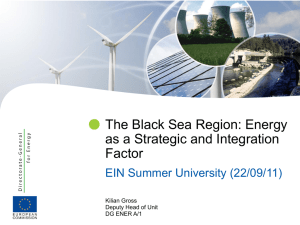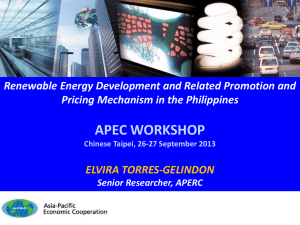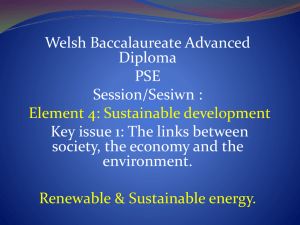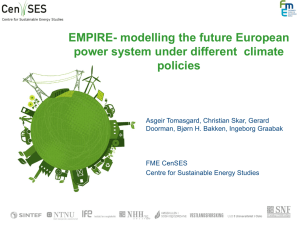Powerpoint file for Chapter 6 (Hydro-electric energy)
advertisement
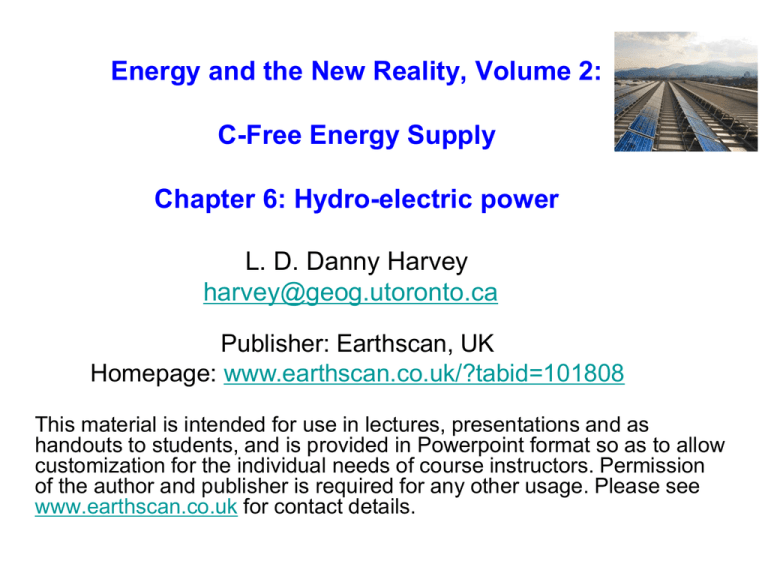
Energy and the New Reality, Volume 2: C-Free Energy Supply Chapter 6: Hydro-electric power L. D. Danny Harvey harvey@geog.utoronto.ca Publisher: Earthscan, UK Homepage: www.earthscan.co.uk/?tabid=101808 This material is intended for use in lectures, presentations and as handouts to students, and is provided in Powerpoint format so as to allow customization for the individual needs of course instructors. Permission of the author and publisher is required for any other usage. Please see www.earthscan.co.uk for contact details. Kinds of hydro-power • Run-of-the-river (no reservoirs) • Reservoir-based Power production: • Mechanical power of flowing water is equal to Pe = ρg Q H where H is the “head” and Q the volumetric rate of flow • Electric power produced is equal to Pe = ηeηt ρg Q H where ηe and ηt are the generator electrical and turbine mechanical efficiencies, respectively Figure 6.1a Low-head hydro-electric system barrage turbine river flow (a) low head Source: Ramage (1996, Renewable Energy, Power for a Sustainable Future, Oxford University Press, Oxford, 183-226 ) Figure 6.1b Medium-heat hydro-electric system reservoir dam turbine penstock (b) medium head Source: Ramage (1996, Renewable Energy, Power for a Sustainable Future, Oxford University Press, Oxford, 183-226 ) Figure 6.1c High-head hydro-electric system high reservoir dam turbine penstock (c) high head Source: Ramage (1996, Renewable Energy, Power for a Sustainable Future, Oxford University Press, Oxford, 183-226 ) Figure 6.2 Impellors a) b) c) Fixed blades d) Adjustable blades (Kaplan) Source: Ramage (1996, Renewable Energy, Power for a Sustainable Future, Oxford University Press, Oxford, 183-226 ) Figure 6.3 Impellor Space 1000 500 MW Pelton Head (m) 100 MW 100 10 MW 1 MW Francis 10 Crossflow 100 kW 20 kW Propeller 3 0.2 1.0 10 100 500 Volumetric Flow Rate (m3 /s) Source: Ramage (1996, Renewable Energy, Power for a Sustainable Future, Oxford University Press, Oxford, 183-226 ) Figure 6.4 Hydro Efficiency 100 Pelton Crossflow Efficiency (%) 80 60 Francis Propeller 40 20 0 0 0.2 0.4 0.6 0.8 Flow as a Proportion of Design Flow Source: Paish (2002, Renewable and Sustainable Energy Reviews 6, 537–556, http://www.sciencedirect.com/science/journal/13640321) 1.0 Figure 6.5 Hydro-electricity generation 3500 Asia Pacific TWh/yr Electricity Generation 3000 2500 Middle East & Africa FSU Europe S & C America North America 2000 1500 1000 500 0 1965 1970 1975 1980 1985 Year 1990 1995 2000 2005 Current hydro-electricity • About 19% of global electrical generating capacity in 2005 (778 GW out of 4100 GW) • About 16% of global electricity generation in 2005 (2838 TWh out of 18000 TWh) Figure 6.6 Top 10 countries and rest-of-world in terms of hydro-electric power capacity in 2005. Total = 778 GW China, 100 USA, 77.4 ROW, 293.2 Canada, 72.0 Sweden, 16.1 Italy , 17.3 France, 25.5 Norway, 27.7 Brazil, 71.1 Russia, 45.7 India, 32 Figure 6.7 Top 10 countries and rest-of-world in terms of hydro-electric generation in 2005. Total = 2838 TWh. Canada, 359.0 ROW, 931.0 Brazil, 338.0 China, 337.0 France, 56.0 Sweden, 72.0 Venezuela, 77.0 India, 97.0 Norway, 136.0 USA, 270.0 Russia, 165.0 Figure 6.8 Percent of total electricity generation as hydro-electricity Norway Brazil Iceland Columbia Venezuela Canada Switzerland New Zealand Chile Sweden 0 20 40 60 Percent Hydro Power in 2005 80 100 Total small-hydro (< 10 MW) Figure 6.9 Hydro-electric generation potential 6000 Technical Potential Economic Potential Existing Total Electricity Demand Electricity Production (TWh/yr) 5000 4000 3000 2000 1000 0 Africa Asia Australasia Europe N&C America S America Hydro-electric generation potentials Table 6.1 Potential energy generation (TWh/yr), existing (2005) of future generation (TWh/yr), total electricity demand (TWh) in 2005, and percent of total electricity demand met by hydro power in various continents and selected countries (listed for each continent in order of decreasing technical potential). UC=under construction. Source: WEC (2007) for hydro generation, UN (2007) for total generation. Figure 6.10a Hydro reservoir power densities 30 Wind energy density (based on foundation area) with 7.5 m/s mean wind speed: about 360 W/m2 25 20 Solar energy density (based on 200 W/m 2 annual mean irradiance and 15% sunlight-to-AC efficiency): 30 W/m2 15 10 5 Boreal Balbina Curua-Una Segredo Itaipu Barra Bonita Miranda Tres Marias Serra da Mesa Xingo Samuel 0 Tucurui Annual Average MW/km2 (W/m2) By comparison: Greenhouse gas emissions • Methane is produced from the decomposition of organic matter already on the land when it is flooded to produce a reservoir (this emission decreases over time) • Methane is also produced from decomposition of organic matter that washes into the reservoir and decays anaerobically • For some projects, the GHG emission per kWh, averaged over the lifetime of the projected, is greater than that from a coal-fired powerplant! • Accurate assessment of the GHG emissions is, however, very difficult Figure 6.10b GHG emissions from dams in Brazil (except for “Boreal”) 8.0 0.7 dos Santos 0.6 Fearnside 0.5 0.4 Coal at 45% efficiency 0.3 0.2 Natural gas at 60% efficiency 0.1 Boreal Balbina Curua-Una Segredo Itaipu Barra Bonita Miranda Tres Marias Serra da Mesa Xingo Samuel 0.0 Tucurui Equivalent CO2 Emission (kgC/kWh) 0.8 Figure 6.11a GHG emissions vs power density for reservoirs in Brazil 600 Samuel CO2-eq Emissions (gC/kWh) 500 400 Tres Marias 300 Barra Bonita 200 Serra da Mesa Tucurui 100 Miranda Segredo Itaipu 0 0 2 4 6 Annual Average Power Density (W/m2) 8 Figure 6.11b GHG emissions vs power density for reservoirs in Quebec 18 Churchill Falls 16 CO2-eq Emissions (gC/kWh) 14 La Grande Complex 12 Manic Complex 10 8 6 Churchill/Nelson 4 Sainte-Marguerite 2 0 0 2 4 6 Annual Average Power Density (W/m2) 8 Capital cost of hydro powerplants • Small hydro, $1000-3000/kW, developing countries • Small hydro, $2000-9000/kW, developed countries • Large hydro (involving dams and reservoirs), $2000-8000/kW (including access roads for high estimates) Figure 6.12 Small-hydro capital cost 10000 9000 8000 US$/kW 7000 6000 International data 5000 4000 3000 2000 1000 Developing country 0 0 500 1000 1500 kW Installed Source: Paish (2002, Renewable and Sustainable Energy Reviews 6, 537–556, http://www.sciencedirect.com/science/journal/13640321) 2000 Cost of hydro-electricity (cents/kWh) Table 6.4 Cost of hydro-electric energy (cents/kWh) for various capital costs, interest rates, and capacity factors, assuming amortization of the initial investment over a 50-year period. Operation and maintenance, insurance, water rent, transmission, and administrative costs are not included.
